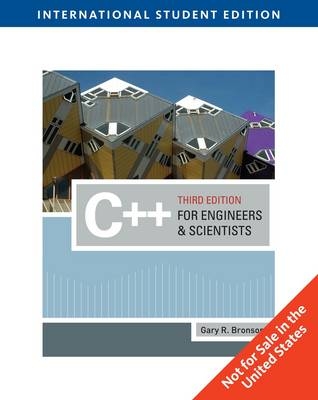
C++ for Engineers and Scientists
Seiten
2009
|
International ed
South-Western (Verlag)
978-1-4390-3950-2 (ISBN)
South-Western (Verlag)
978-1-4390-3950-2 (ISBN)
- Titel erscheint in neuer Auflage
- Artikel merken
Introduces C++ to first-level engineering students. This work offers case studies and a selection of examples from a variety of fields including thermodynamics, optics, and fluid mechanics.
Now in its third edition, Bronson's C++ FOR ENGINEERS AND SCIENTISTS, International Edition makes C++ accessible to first-level engineering students as C++ maintains its stronghold in engineering and scientific communities. The text continues to take a pragmatic approach that incorporates actual engineering and science problems for its applications and examples. Students begin with a foundation in procedural programming, moving into object-oriented concepts in the second half of the text. This new edition also offers new case studies and an expanded selection of examples from a variety of fields including thermodynamics, optics, and fluid mechanics.
Now in its third edition, Bronson's C++ FOR ENGINEERS AND SCIENTISTS, International Edition makes C++ accessible to first-level engineering students as C++ maintains its stronghold in engineering and scientific communities. The text continues to take a pragmatic approach that incorporates actual engineering and science problems for its applications and examples. Students begin with a foundation in procedural programming, moving into object-oriented concepts in the second half of the text. This new edition also offers new case studies and an expanded selection of examples from a variety of fields including thermodynamics, optics, and fluid mechanics.
PART I u FUNDAMENTALS. 1. Preliminaries. 2. Application Solving Using C++. 3. Assignment, Formatting, and Interactive Input. 4. Selection Statement. 5. Repetition Statements. 6. Modularity Using Functions. 7. I/O File Streams and Data Files. 8. Arrays. 9. Completing the Basics. PART II - OBJECT-ORIENTED PROGRAMMING. 10. Introduction to Classes. 11. Class Functions and Conversions. PART III - DATA STRUCTURES. 12. Pointers. 13. Structures. PART IV - ADDITIONAL TOPICS. 14. Numerical Methods. 15. Bit Operations. Appendices. A. Operator Precedence Table. B. ASCII Character Codes. C. Floating Point Number Storage. D. Command Line Arguments.
| Verlagsort | Mason, OH |
|---|---|
| Sprache | englisch |
| Maße | 188 x 234 mm |
| Gewicht | 1294 g |
| Themenwelt | Mathematik / Informatik ► Informatik ► Programmiersprachen / -werkzeuge |
| Informatik ► Software Entwicklung ► Objektorientierung | |
| Schlagworte | EDV |
| ISBN-10 | 1-4390-3950-X / 143903950X |
| ISBN-13 | 978-1-4390-3950-2 / 9781439039502 |
| Zustand | Neuware |
| Haben Sie eine Frage zum Produkt? |
Mehr entdecken
aus dem Bereich
aus dem Bereich
objektorientierte Entwicklung modularer Maschinen für die digitale …
Buch | Hardcover (2024)
Hanser (Verlag)
44,99 €
Entwicklung von GUIs für verschiedene Betriebssysteme
Buch (2023)
Hanser, Carl (Verlag)
39,99 €
Principles and Practice Using C++
Buch | Softcover (2024)
Addison Wesley (Verlag)
85,95 €


